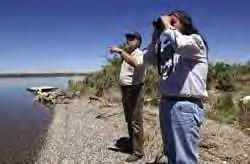|
|
Canku Ota |
|
|
(Many Paths) |
||
|
An Online Newsletter Celebrating Native America |
||
|
June 2, 2001 - Issue 37 |
||
|
|
||
|
Reuniting the Tribal Nations |
||
|
by Emily Jones The Idaho State Journal |
||
|
Minidoka Wildlife Refuge manager Steve Bouffard and Shoshone-Bannock
Olympic Committee chairman Garth Towersap look at possible camping sites for the Suquamish Tribe. |
 AMERICAN
FALLS, ID — When the Shoshone-Bannock Olympic Committee welcomes members of the Suquamish tribes from a long canoe
trip from the Pacific Ocean in August, it will be the start of something very important, director Garth Towersap
said. AMERICAN
FALLS, ID — When the Shoshone-Bannock Olympic Committee welcomes members of the Suquamish tribes from a long canoe
trip from the Pacific Ocean in August, it will be the start of something very important, director Garth Towersap
said. The committee is planning a Reunion of Nations, where tribes come together to share their cultures and to discuss ways they can work together. The Suquamish tribe will paddle canoes from their homes near the Pacific Ocean to the Fort Hall bottoms in August. Towersap and Minidoka National Wildlife Refuge manager Steve Bouffard were looking for good places for the tribe to camp near Raft River. Towersap said he is hoping to invite tribes from all over the Northwest and Midwest to the event. He said he hoped to have an exchange of cultures and ideas. Towersap and his committee will also solicit volunteers for Olympic activities, and ask the tribes to help them plan. Having many tribes meet is important for the future, Towersap said. "It's never happened before," he said. "It's critical. Times are changing." The Suquamish people are still in the process of planning the route they will take to Fort Hall, but they plan to travel from the Pacific Ocean up the Columbia River, then follow the Snake River from Lewiston, down through Boise, past Massacre Rocks State Park and to the Fort Hall bottoms. The group will travel in 25 to 30-foot long cedar canoes made for ocean canoeing. Towersap said he hoped the venture will raise awareness for salmon restoration. "If it's hard for a human to travel around dams; just think how difficult it will be for a fish," he said. Towersap hopes having the many tribes together will help bring attention to the American Indian culture. The Fort Hall area was a trade zone for American Indians in the 1800s, Towersap said, and he hopes tribes will exchange ideas and parts of their cultures. "We want to dispel the notion we're extinct, because we're not," he said. "The opportunity for communication is there. We might as well talk." |
|
Celebrating the Traditions of the Shoshone - Bannock
Tribes |
|
|
||
|
|
||
| Canku Ota is a free Newsletter celebrating Native America, its traditions and accomplishments . We do not provide subscriber or visitor names to anyone. Some articles presented in Canku Ota may contain copyright material. We have received appropriate permissions for republishing any articles. Material appearing here is distributed without profit or monetary gain to those who have expressed an interest. This is in accordance with Title 17 U.S.C. section 107. | ||
|
Canku Ota is a copyright © 2000, 2001 of Vicki Lockard and Paul Barry. |
||
|
|
|
|
|
The "Canku Ota - A Newsletter Celebrating Native America" web site and its design is the |
||
|
Copyright © 1999, 2000, 2001 of Paul C. Barry. |
||
|
All Rights Reserved. |
